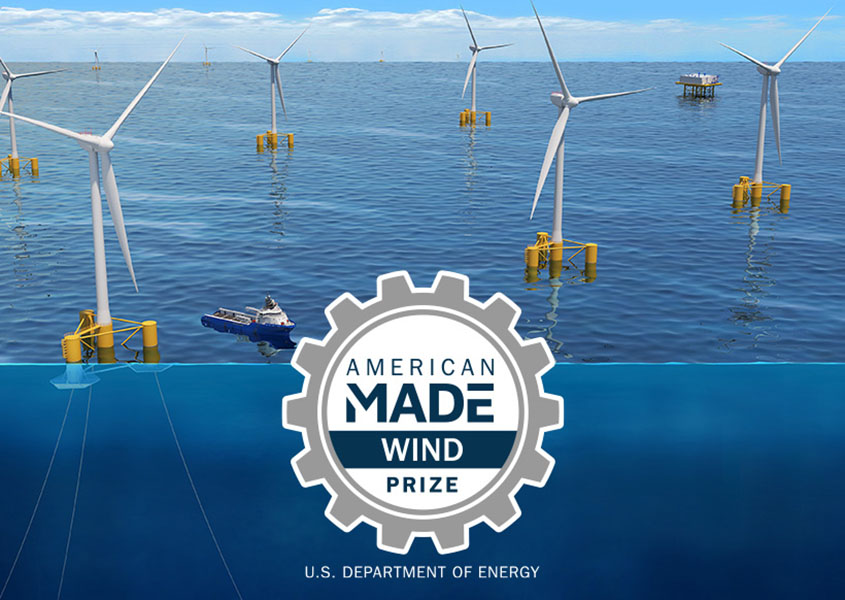FLOWIN Forward: Nine Teams Advance to Phase Two of the First Wind Energy Prize
Phase One Winners Demonstrated How Their Floating Offshore Wind Energy Platform Designs Are Ready To Move Toward Mass Manufacturing
With nine Phase One winners named, the first phase of the three-phase American-Made FLoating Offshore Wind ReadINess (FLOWIN) Prize has concluded, kicking off Phase Two.
Each Phase One winner will receive $100,000 in cash and $75,000 in vouchers for technical support provided by the U.S. Department of Energy’s national laboratories, along with an invitation to compete in Phase Two of the competition. In total, the FLOWIN Prize has a cash pool of $5.85 million, plus up to $1.175 million in technical support.
Launched in September 2022 and administered by the National Renewable Energy Laboratory (NREL), the prize aims to help unlock the nation’s offshore wind energy potential by accelerating manufacturing and deployment of U.S. floating offshore wind energy technology. The FLOWIN Prize is the first prize funded by the U.S. Department of Energy’s Wind Energy Technologies Office.
The Challenge: Design Cost-Effective Floating Offshore Wind Platforms Ready for Mass Manufacturing in the United States
About two-thirds of the nation’s offshore wind resource potential can be found in areas where the water is over 60 meters deep—areas where floating offshore wind turbines are likely more practical and cost-effective than fixed-bottom turbines. The FLOWIN Prize challenges designers, fabricators, and project site developers to help unlock this potential.
Competing teams tackle the floating offshore wind energy industry’s biggest supply chain challenges by addressing manufacturing and logistics gaps. In addition, the ideas and designs generated throughout this competition aim to help the nation meet the White House's goals to reduce the cost of floating offshore wind by 70% and deploy 15 gigawatts by 2035.

The FLoating Offshore Wind ReadINess (FLOWIN) Prize is an American-Made Challenges competition designed to accelerate the market readiness of U.S. floating offshore wind energy technologies. Graphic by Besiki Kazaishvili, NREL
The Phase One Winners
The winning teams of Phase One of the FLOWIN Prize are:
- Aikido Technologies (San Francisco, California). The Aikido design is a steel semisubmersible floating platform made of steel tubes that can be manufactured at tower facilities. The platform design offers a streamlined installation process because it can be transported in a unique, horizontal configuration and requires no welding during the final assembly process.
- Beridi USA (Spanish Fork, Utah). Beridi’s Triwind is a concrete-based floating platform that uses damping pools and buoyancy chambers to provide superior stability, limiting fatigue loading. The platform can be mass-manufactured at existing sea ports to provide cost savings.
- FloatHOME (Emeryville, California). FloatHOME’s triangular platform, WindFloat, now in its fourth generation, provides deep-water stability through unique design features, including a damping system to absorb wave excitation movement. This platform has been fully modularized to enable differing execution plan options, allowing for streamlined manufacturing and adaptable installation.
- OCG-Wind Full Cycle (Oakland, California). By prefabricating necessary parts, OCG-Wind Full Cycle can be quickly assembled near the site of an offshore wind farm. The lightweight four-column semisubmersible floating platform design uses simple, slender components engineered for any wind turbine, making it customizable and ready for large-scale deployment.
- PelaStar (Seattle, Washington). PelaStar’s floating platform is a lightweight tension-leg platform design that minimizes environmental impacts while maintaining cost savings as well as manufacturing and installation flexibility.
- Technip Energies (Houston, Texas). Technip Energies’ INO15 design is a semisubmersible, three-column floating platform. This design can be assembled at ports at low cost and is robust enough to withstand harsh operating environments.
- Tetra Triple-One (Boston, Massachusetts). The Tetra Triple-One floating platform uses a building-block arrangement, which involves fully producing the parts needed in an industrialized manufacturing environment and then transporting them to the assembly site. This makes portside construction possible for a range of platform configurations, turbine sizes, and site conditions.
- VolturnUS+ Domestically Produced Concrete Hull (Orono, Maine). This team focused on a simplified geometry for their concrete floating platform design, VolturnUS+. With a smaller hull compared to traditional semisubmersibles, the design streamlines construction and deployment processes and reduces costs.
- WHEEL U.S. (Coral Gables, Florida). Incorporating tanks for buoyancy and balance, the ultrastable WHEEL floating platform design can temporarily act as a barge platform, allowing it to be assembled with the wind turbine near shore and towed to sea. It is compact in size to reduce both costs and carbon footprint.
Up Next: U.S. Manufacturing Approaches
The nine winners of Phase One are invited to compete in Phase Two of the competition, in which each team will develop a pathway for mass manufacturing and deployment of its floating offshore wind energy substructure design.
In Phase Two, judges will award up to five winners, each of whom will receive $450,000 in cash and technical services vouchers valued at $100,000. The competing teams will be judged on their progress in developing a plan for mass manufacturing and deployment of gigawatt-scale, floating offshore wind energy farms.
For more information, follow the FLOWIN Prize on HeroX. The FLOWIN Prize is administered by NREL in partnership with the Business Network for Offshore Wind on behalf of the U.S. Department of Energy’s Wind Energy Technologies Office in support of the interagency Floating Offshore Wind Shot.
Explore NREL's research and development in offshore wind energy and subscribe to the laboratory's wind energy newsletter to get news like this in your inbox each month.
Last Updated May 28, 2025
